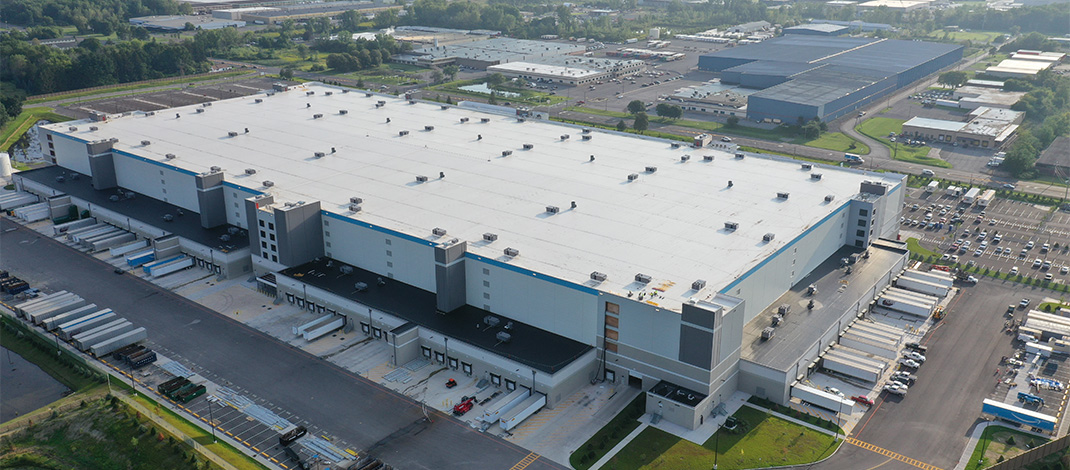By Ken Sturtz
While Amazon has scrapped new warehouses and delayed some projects already under construction, it’s doubling its workforce in Clay to 3,000 workers
The headlines for the world’s second-largest company have been decidedly negative this year.
Amazon hemorrhaged billions as e-commerce slowed coming out of the pandemic. A nationwide building spree saddled it with more space and workers than it now needs. Further headwinds may be on the way as Congress considers new antitrust legislation aimed at big technology companies like Amazon.
But those problems seem distant at its mammoth warehouse and fulfillment center on Morgan Road in Clay — known in company jargon as SYR1 — where Amazon is actually expanding.

When the 3.8-million-square-foot space opened in April the company said it planned to hire 1,000-1,500 full-time workers. This summer company officials announced they had reached an initial hiring goal of 1,500 workers and were hiring an additional 200 people a week with the goal of having 3,000 employees when the holiday shopping season begins in October.
The news that Amazon was expanding and hiring even more workers in Central New York was made more surprising by the fact that the company is doing the opposite across its footprint.
In July Amazon reported losing $2.03 billion in the second quarter of 2022, compared to a nearly $8 billion profit last year. It was the second consecutive quarter of losses.
Several factors are at play. The spike in online shopping during the pandemic has ebbed as Americans return to in-person shopping and shift their spending from consumer goods to things they couldn’t do during the height of the pandemic, such as travel or dining out. The highest inflation in 40 years has sent costs rising, causing some to ease away from unnecessary spending.
But it was a strategy Amazon adopted during the pandemic that is causing the largest headaches.
“The big issue is they overbuilt,” said Patrick Penfield, a professor of supply chain practice at Syracuse University. “They went on just a major expansion on all their warehouses.”
Amazon nearly doubled the number of warehouses and data centers it leased and owned between 2019 and 2021.
Penfield said Amazon probably believed consumers who turned to e-commerce during the pandemic would change their habits and continue buying online, and that building more warehouses would put it ahead of the curve. That bet has not paid off, however, as consumers have increasingly returned to shopping in person.
Amazon’s strategy was overly aggressive and led to losses that are unsustainable long-term, Penfield said, resulting in its move to retrench, control costs and optimize its current network.
“I think they’re realizing that they’ve got a pretty big footprint in place right now and they need to reap the rewards of that footprint and start making money off of what they already have built up,” he said.
Amazon has scrapped new warehouses and other facilities that were still in the planning phase and delayed some projects already under construction.
In the U.S. Amazon has purposely delayed opening 18 projects by leaving buildings idle and forgoing hiring employees, said Marc Wulfraat, president of MWPVL International, a Montreal-based global supply chain and logistics consulting firm. That’s the case with a fulfillment center near Rochester that was supposed to open in 2022 and another in the Buffalo market. Delayed facilities are unlikely to be operational until 2023 or 2024.
“They’re trying to reduce their operating expenses in order to be profitable again,” Wulfraat said. “And a key part of that is just a delayed opening at a number of fulfillment centers.”
Amazon is also delaying opening smaller facilities, but its giant fulfillment centers typically cost the most to run. With a thousand or more employees the annual payroll can exceed $40 million. At the end of June Amazon had 1.52 million employees company wide, down 6% from earlier in the year. The staffing reduction was achieved through attrition.
Although Amazon has closed and subleased a handful of its buildings, that’s been the exception rather than the rule.
The growth of staffing and capacity at the Clay warehouse can be explained by the fact that it’s a key piece of Amazon’s network. It is the company’s largest facility in New York state, serving much of Upstate New York and parts of Massachusetts and Connecticut. It’s slated to serve other states in the future.
About 30,000 products a day are shipped from the warehouse. Company officials said that number will grow to 150,000.
The Clay warehouse is currently the closest fulfillment center to Buffalo and Rochester and many of the packages it handles are sent there. The next closest facility to Buffalo, for example, is in Cleveland. The Buffalo, Rochester and Syracuse metro areas total about 2.9 million people in close proximity along the Thruway.
“When you combine those three cities together there’s a lot of people there that need to be served with their Amazon product,” Wulfraat said.
That could change in a couple years. Once fulfillment centers in the Buffalo and Rochester areas become operational the total volume that the Clay warehouse handles could drop off, Wulfraat said. In the long run that could lead Amazon to scale back its Central New York workforce to deal with the changes, likely through attrition.
“They just celebrated their opening and so no one’s thinking right now about anything like that,” he said. “But eventually what happens is the volume is always going to get pulled from the closest warehouse nearest the customer.”
But Amazon wouldn’t close its Clay warehouse because of the massive financial commitment involved in building the facility, Wulfraat said.
It’s also an important part of Amazon’s long-term goal to offer same-day service to most of the country.

“As soon as you place an order with them they want to be able to fill it that day,” Penfield said. “That warehouse goes a long way in really being able to accommodate that particular strategy.”
It’s easy to overstate Amazon’s recent troubles. Even with its slumping retail business, Amazon’s $121.2 billion in revenue still beat expectations and its advertising and cloud computing divisions continued to do well.
The company is also in a good position to improve its performance heading into the holiday season. Barring major transportation issues, such as with the longshoremen’s union contract negotiations, railroad staffing shortages and tight trucking industry capacity, Amazon has a big opportunity to gain back ground and make money in the second half of the year, Penfield said.
And the company’s efforts to control costs are ultimately short-term measures that haven’t affected its long-term strategy, Wulfraat said.
“They are not slamming on the brakes and going into reverse or anything like that,” he said. “This is a year when all they’re doing is taking their foot off the accelerator pedal.”




